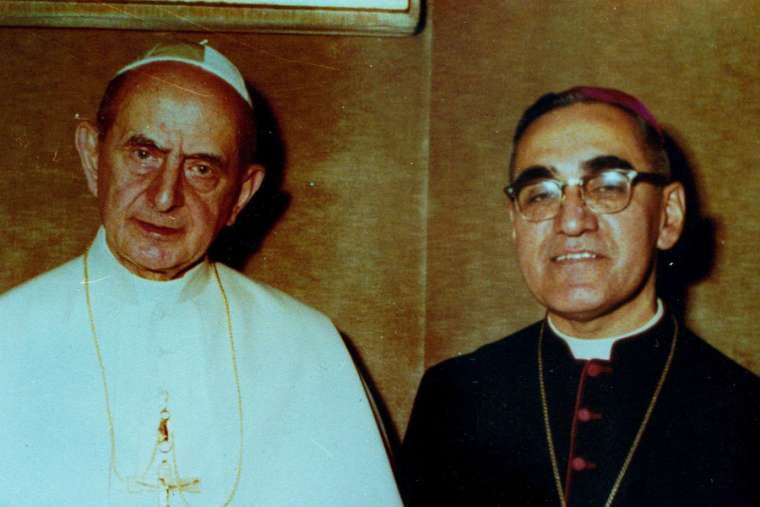Earlier this month, Pope Francis added a new liturgical celebration to the Roman Calendar. In a joint declaration with Cardinal Sarah, Prefect for the Congregation for Divine Worship, he named the Monday following Pentecost a mandatory memorial commemorating Mary, Mother of the Church. The new memorial, “encourage(s) the growth of the maternal sense of the Church in the pastors, religious and faithful, as well as a growth of genuine Marian piety,” Cardinal Sarah said. Later in the same month, Francis officially opened the door for the canonization of Bl. Óscar Romero and Bl. Pope Paul VI.
Its rare, in today’s polarized Church, for the author of Humanae Vitae and the hero of liberation theologians to be celebrated in the same context. In this day and age, only a mother would put forth both of these men as models. Only a mother would publicly proclaim pride in both of their accomplishments and claim them as her own.
It’s not that the two didn’t get along that makes this a paradoxical announcement. In fact, they had a very amiable relationship. However, today Paul VI and Óscar Romero represent very different wings of a sharply polarized Church. For some, Paul VI’s Humanae Vitae is a symbol for a rule- and authority-oriented Church excessively focused on sexual morality, while many see Romero’s writing, fighting, and dying for the sake of the poor as fueling revolutions for social justice. It wouldn’t be much of a stretch to describe the Church’s polarization as a feud between Paul VI Catholics and Óscar Romero Catholics.
Mary Ellen Konieczny writes, “In recent years, divisions around issues that are by now all too familiar—perhaps most notably, issues of gender, sexuality, and authority—have rent the Catholic Church in the United States.” We can point to Paul VI’s Humanae Vitae as a pretext for this polarization. Its proponents hail it as prophetic, arguing that the opposition and rejection of its teaching led to the collapse of marriage, legalized abortion, and an over-sexualized culture. Further, Paul VI and Humanae Vitae have become a symbol of papal and magisterial authority. The encyclical ushered in a new dimension of contemporary Catholic life that has divided Catholics on the issue of dissent. Under Paul’s putative patronage, Catholics have found energy to defend the Church’s traditional sexual morality, the magisterial authority, and push an agenda that no doubt leans to the right.
In the same way that Paul’s encyclical ushered in a new dynamic, so did Romero’s death. The very declaration of his “martyrdom” was stalled for years on the premise that he died for politics rather than faith. Under his patronage, many have taken up a faith that seeks justice, a faith manifested in political and social movements. It is no question that these movements lean to the left, often clashing with those defending traditional sexual morality in the culture wars. While perhaps not always hostile to papal authority, these Catholics are more likely to see the value in something like base communities, local community churches, and prize individual experience over magisterial pronouncements and official church teaching.
Thus, we find ourselves in our present polarization. On one side we have faithful Catholics showing up to support the Little Sisters of the Poor in their battle against the birth control mandate. On the other, we have faithful Catholics supporting the sisters getting arrested for the cause of Dreamers.
Of course, the classic right-left categorizations within the Church are not always accurate. Many Catholics, especially millennials, are transcending these polarized categories more and more. It is also unfair to categorize Paul VI and Romero in terms of these divides. Paul VI supported Romero in his fight against the militaristic government, published social encyclicals, and denounced war. Archbishop Romero was deeply loyal to Rome, received spiritual direction from an Opus Dei priest, and advocated the canonization of their more traditional and conservative founder, St. Josemaría Escrivá.
They have, however, become symbols in the broader left-right divide. After decades of these and other figures being co-opted for polemical purposes, we find it difficult to imagine a Catholic who holds them both up as models and claims them both for their own.
And so have a new memorial to commemorate Mary, Mother of the Church. Perhaps in times like ours, we do need a genuine growth of Marian piety. Maybe then our frustration, anger, and disagreements could be based not in hate, but first and foremost, in real and deep love. The love of a mother.
A polarization that frames Paul VI and Óscar Romero as more different than similar is foreign to this love. Maybe our growth in devotion to Mary could seek her help to receive both Fr. James Martin and Ross Douthat first as cherished co-members in the Body of Christ. Maybe we could ask her to help us see both Cardinal Cupich and Cardinal Burke through the eyes of their mother. With her help, we could begin to imagine a heart equally pierced with love for Sister Elizabeth Johnson and Mother Angelica.
Mary can help us work through our divisions. I do mean work through – not ignore. There is no need to gloss over our differences or pretend they are not grave. But how much holier, how much more prophetic could the Church be if we approached these differences with the eyes and heart of our Mother.
Blessed Óscar Romero, Pray for us!
Blessed Pope Paul VI, Pray for us!
Mary, Mother of the Church, Pray for us!


